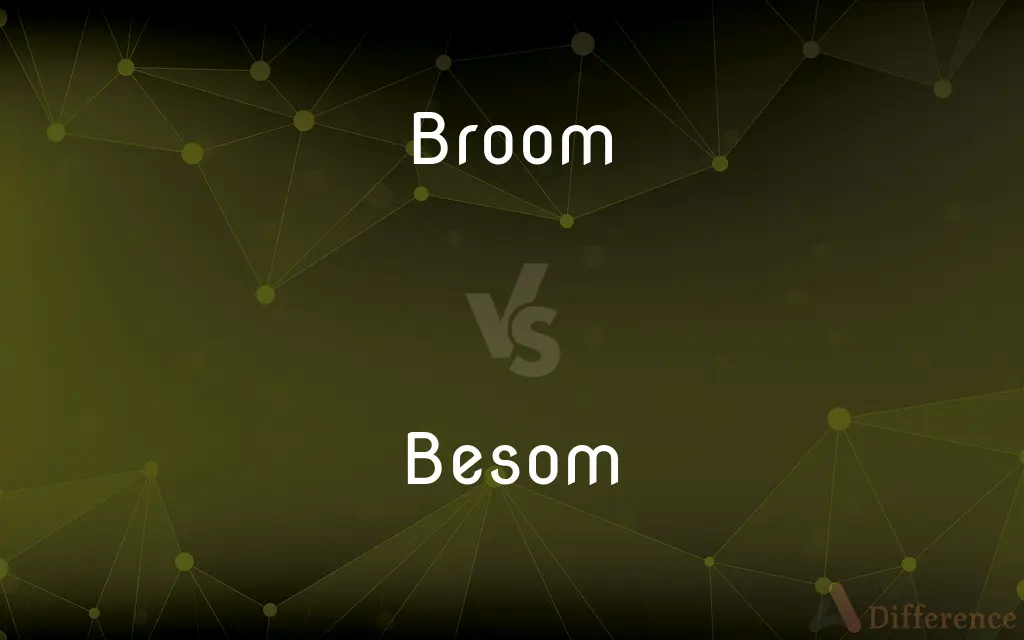Broom vs. Besom — What's the Difference?
By Urooj Arif & Fiza Rafique — Updated on April 17, 2024
A broom typically refers to a cleaning tool with synthetic bristles, while a besom is a traditional broom made from natural materials like twigs.

Difference Between Broom and Besom
Table of Contents
ADVERTISEMENT
Key Differences
Brooms are common household cleaning tools designed with synthetic or natural bristles attached to a long handle, used for sweeping floors indoors and outdoors. In contrast, besoms are traditional brooms, often made entirely from natural materials such as birch twigs bound to a sturdy wooden handle, primarily used in garden settings or for rustic decor.
Modern brooms often feature stiff synthetic bristles that are effective on various surfaces and are durable under many conditions. Whereas, besoms are made with softer, natural materials which might not last as long or be as effective on modern flooring but are preferred for certain surfaces like cobblestones or uneven natural paths to prevent damage.
The design of a typical broom includes a straight, usually plastic or metal handle for easy grip and maneuverability. Meanwhile, a besom handle can be uneven, as it is often made from natural wood branches, which adds to its traditional aesthetic but might reduce comfort during extended use.
In terms of usage, brooms are versatile and can be used in many environments, from kitchens to garages, adapting well to different types of debris. Besoms, however, are often favored for outdoor use, particularly in gardening, as they gently sweep away leaves and dirt without disturbing underlying sand or soil.
Brooms and besoms also differ culturally and historically. Brooms have evolved with industrial materials and designs to meet modern needs, while besoms are steeped in tradition, often associated with folklore and historical practices of witchcraft.
ADVERTISEMENT
Comparison Chart
Materials
Synthetic bristles, plastic or metal handle
Natural twigs, wooden handle
Durability
High, suitable for various surfaces
Lower, best for specific, gentle uses
Design
Straight handle, uniform bristles
Natural branch handle, uneven bristles
Preferred Usage
Indoor and outdoor, versatile
Mostly outdoor, especially gardens
Cultural Significance
Modern, utilitarian
Traditional, historical, folklore-related
Compare with Definitions
Broom
A cleaning tool with bristles affixed to a handle.
She used a broom to sweep the kitchen floor.
Besom
A traditional broom made from natural materials.
The gardener used a besom to sweep the fallen leaves.
Broom
Utilitarian and practical for everyday use.
He grabbed the broom to clean up the broken glass.
Besom
Features a rustic design with a wooden handle.
The besom stood in the corner, adding to the cottage's rustic charm.
Broom
Often synthetic, designed for effective cleaning.
The new broom's synthetic bristles cleaned the garage effortlessly.
Besom
Favored for its traditional aesthetics and functionality.
He preferred the besom for its traditional look during autumn clean-ups.
Broom
Durable and adaptable to various environments.
Their broom lasted years, even with rough outdoor use.
Besom
Best used for gentle sweeping in natural settings.
Using the besom, she carefully cleaned the garden path.
Broom
Common in household cleaning routines.
Weekly chores included sweeping with the sturdy broom.
Besom
Historically linked to folklore and old customs.
The besom by the fireplace evoked images of historical witchcraft tales.
Broom
A broom (also known in some forms as a broomstick) is a cleaning tool consisting of usually stiff fibers (often made of materials such as plastic, hair, or corn husks) attached to, and roughly parallel to, a cylindrical handle, the broomstick. It is thus a variety of brush with a long handle.
Besom
A besom is a broom, a household implement used for sweeping. The term is now mostly reserved for a traditional broom constructed from a bundle of twigs tied to a stout pole.
Broom
An implement used for sweeping, typically consisting of a bunch of stiff synthetic fibers or broomcorn stalks, or formerly twigs or straw, bound together and attached to a handle.
Besom
A bundle of twigs attached to a handle and used as a broom.
Broom
Any of various European and North African shrubs of the genus Cytisus in the pea family, especially C. scoparius, having mostly compound leaves with three leaflets and showy, usually bright yellow flowers.
Besom
A broom made from a bundle of twigs tied onto a shaft.
Broom
Any of several similar or related shrubs, especially in the genera Genista and Spartium.
Besom
A troublesome woman.
Broom
To sweep with a broom.
Besom
Any cleansing or purifying agent.
Broom
(countable) A domestic utensil with fibers bound together at the end of a long handle, used for sweeping.
Besom
To sweep.
Broom
An implement with which players sweep the ice to make a stone travel further and curl less; a sweeper.
Besom
A brush of twigs for sweeping; a broom; anything which sweeps away or destroys.
I will sweep it with the besom of destruction.
The housemaid with her besom.
Broom
Any of several yellow-flowered shrubs of the family Fabaceae, in the tribe Genisteae, including genera Cytisus, Genista, and Spartium, with long, thin branches and small or few leaves.
Besom
To sweep, as with a besom.
Rolls back all Greece, and besoms wide the plain.
Broom
A shotgun, because it is more or less long, held similarly to a besom and “cleans” what is in front.
Besom
A broom made of twigs tied together on a long handle
Broom
To sweep with a broom.
Broom
(roofing) To improve the embedding of a membrane by using a broom or squeegee to smooth it out and ensure contact with the adhesive under the membrane.
Broom
(metaphor) to get rid of someone, like firing an employee or breaking up with a girlfriend, to sweep another out of one's life
Broom
A plant having twigs suitable for making brooms to sweep with when bound together; esp., the Cytisus scoparius of Western Europe, which is a low shrub with long, straight, green, angular branches, minute leaves, and large yellow flowers.
No gypsy cowered o'er fires of furze and broom.
Broom
An implement for sweeping floors, etc., commonly made of the panicles or tops of broom corn, bound together or attached to a long wooden handle; - so called because originally made of the twigs of the broom.
Broom
See Bream.
Broom
A cleaning implement for sweeping; bundle of straws or twigs attached to a long handle
Broom
Any of various shrubs of the genera Cytisus or Genista or Spartium having long slender branches and racemes of yellow flowers
Broom
Common Old World heath represented by many varieties; low evergreen grown widely in the northern hemisphere
Broom
Sweep with a broom or as if with a broom;
Sweep the crumbs off the table
Sweep under the bed
Broom
Finish with a broom
Common Curiosities
What is a besom?
A besom is a traditional broom made from natural materials like twigs.
What is a broom?
A broom is a cleaning tool with synthetic or natural bristles attached to a handle.
How do I care for a besom to ensure its longevity?
Store it in a dry place and use it gently to avoid damaging the natural bristles.
Why might someone choose a besom over a modern broom?
For its gentle cleaning properties and traditional aesthetic.
What should I consider when buying a broom?
Consider the surface you will clean and the durability of materials.
How do brooms differ from besoms in terms of materials?
Brooms often use synthetic materials, whereas besoms are made from natural twigs.
Can a broom be used for the same purposes as a besom?
While both can sweep, brooms are more versatile and durable on various surfaces.
Can besoms be used in any modern cleaning situation?
While they have limitations, they can still be effective for specific tasks like sweeping leaves or light dirt outdoors.
Where are besoms most effectively used?
Besoms are most effective outdoors, especially in gardens.
Are besoms suitable for indoor use?
They can be used indoors but are less effective on smooth, modern floors compared to brooms.
What makes besoms special in cultural contexts?
Besoms have historical and folklore significance, often associated with traditional rituals.
What are the practical benefits of using a modern broom?
Modern brooms offer durability and effectiveness on a wide range of surfaces.
How has the design of brooms evolved over time?
Brooms have evolved to incorporate synthetic materials for better cleaning efficiency and durability.
What cultural significance does the besom have?
Besoms are often linked to European witchcraft lore and traditional British households.
Is a besom eco-friendly?
Yes, being made from natural materials, besoms are environmentally friendly.
Share Your Discovery

Previous Comparison
Elastic vs. Rigid
Next Comparison
Screw vs. SpiralAuthor Spotlight
Written by
Urooj ArifUrooj is a skilled content writer at Ask Difference, known for her exceptional ability to simplify complex topics into engaging and informative content. With a passion for research and a flair for clear, concise writing, she consistently delivers articles that resonate with our diverse audience.
Co-written by
Fiza RafiqueFiza Rafique is a skilled content writer at AskDifference.com, where she meticulously refines and enhances written pieces. Drawing from her vast editorial expertise, Fiza ensures clarity, accuracy, and precision in every article. Passionate about language, she continually seeks to elevate the quality of content for readers worldwide.
















































